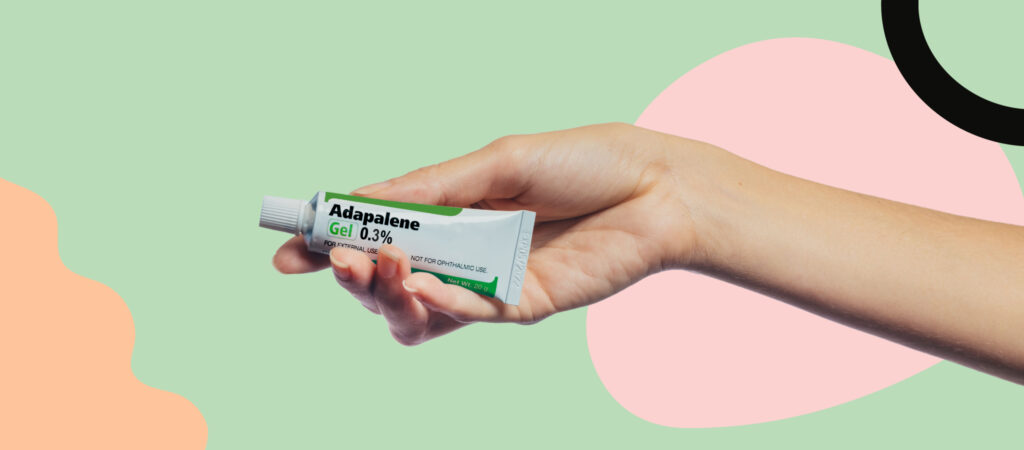From Adapalene to Zinc Oxide: Common Skincare Ingredients You Should Know

Medically reviewed by Dr. Nancy Shannon, MD, PhD on July 13, 2021
With so, so many skincare products filling the drugstore shelves, ecommerce pages and social media ads, choosing the right ones for you can feel overwhelming. It helps to understand what various skincare ingredients do, and while it can be easy to let your eyes glaze over at the sight of compounds and chemicals on an ingredients list, a little education can go a long way in helping you decipher it all.
Whether you’re applying topicals to get rid of acne, treat rosacea, or simply keep your skin clean and moisturized, knowing what makes your skincare products work is crucial for using them correctly. You may have certain allergies, or some ingredients may react poorly with your skin type. Here’s what you need to know about some of the most common skincare ingredients:
Alpha-Hydroxy and Polyhydroxy Acids
Alpha-hydroxy acids, AHAs for short, are some of the most prevalent naturally-derived skincare ingredients. Citric, lactic, and glycolic acid are all AHAs, included in cleansers and serums intended to prevent acne or dullness by exfoliating the top layers of skin. Polyhydroxy acids, PHAs, function similarly to AHAs by exfoliating the skin and reducing collagen breakdown, but the cellular structure of PHAs means that they operate solely on the uppermost layer of the skin.
Nurx offers prescription treatment for acne, anti aging, melasma, rosacea, and eyelash growth.
Salicylic Acid
Between alpha- and polyhydroxy acid is beta-hydroxy acid, generally known as salicylic acid. Beta hydroxy acids are lipid soluble, unlike alpha hydroxy acids, which are water soluble. Because they are lipid soluble, beta hydroxy acids are able to penetrate deeper in the skin via the sebaceous (oil) glands. Salicylic acid is one of the most common over the counter treatments for acne. The acid floods your pores and helps clear out dead skin cells, helping prevent acne formation. Often used alongside benzoyl peroxide, salicylic acid can be applied to any skin type, though there may be some slight irritation in the first few days of usage.
Retinoids
Retinoids are a class of Vitamin A derivatives that speed skin cell turnover, boost collagen production and unclog pores. Retinol and adapalene are the retinoids you’ll see on ingredient labels of over-the-counter products. Prescription topical retinoids include tretinoin, adapalene (0.3%), and tazarotene. Retinoids are used to treat mild to moderate cases of acne, to reduce signs of sun-related aging, and sometimes to alleviate psoriasis and keratosis pilaris. Retinoids are available in both over-the-counter and prescription strengths. Retinol is an ingredient in many over-the-counter formulations, adapalene was formerly prescription-only but now is available over-the-counter, and tretinoin requires a prescription.
Sulfur and Sulfates
Sulfur is a common ingredient in skincare products designed to combat acne. When sulfur is applied to the skin, it absorbs excess oil, preventing it from clogging pores. Sulfur is a particularly popular ingredient for leave-on topical treatments. Unfortunately, some sulfur-containing products can have a bit of the notorious “rotten eggs” smell.
As the name suggests, sulfates are compounds which include sulfur as one of the elements included. Sulfates are more commonly found in cleansers and soaps and are responsible for creating lather. Sulfates may be an irritant for those with sensitive skin.
Titanium Dioxide and Zinc Oxide
Titanium dioxide and zinc oxide are the most common ingredients in what are known as physical or “mineral” sunscreens — products that get their name from the fact that they act as physical barriers between your skin and the sun’s UV radiation. They work by reflecting away the sun’s rays from the skin’s surface. Both compounds are generally well-tolerated even by people with sensitive skin and rosacea.
Hyaluronic Acid
Hyaluronic acid is a naturally occurring substance that maintains skin’s moisture and smooth appearance. Synthetic formulations are one of the most popular “anti-aging” skin ingredients available today, because of its ability to maintain proper moisture levels for the skin: hyaluronic acid can hold up to 1000 times its weight in water. Hyaluronic acid can be found in topical creams, serums, and ointments and also makes up the active ingredient in injectable fillers. But be advised: some formulations of hyaluronic acid may act as an irritant for those with sensitive skin.
Alcohol
Alcohol applied directly to the skin can dry it out significantly, which has made it a fairly common ingredient in inexpensive drugstore acne treatments. In theory, keeping the pores dry prevents them from clogging and forming pimples, and alcohol can kill pimple-forming bacteria. However alcohol can also be irritating to the skin and lead to excess sebum production that makes acne worse in the end. There are, however, some alcohols, such as fatty alcohols and ethanol, that can help clear pores without causing significant levels of irritation.
Ascorbic Acid
L-ascorbic acid, a formulation of Vitamin C, is something of an all-around skin improver. When applied regularly, L-ascorbic acid can prevent wrinkle development, prevent collagen degradation, and help heal the skin if it’s been damaged. Best of all, L-ascorbic acid is very unlikely to irritate the skin: while some may experience slight yellow discoloration of the skin, most will notice no side effects.
Water
It likely goes without saying, but water is a crucial ingredient of just about every single skincare product. It’s worth being aware of all the same because water-based products are generally preferable to oil or alcohol-based products due to the fact that water is a non-irritating solvent.
If you’re still having difficulty figuring out which skincare products are best for you, we’re here to help. Get in contact with a member of our team of skincare experts today to learn more about what your options may be.







